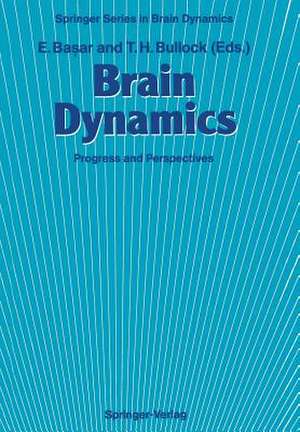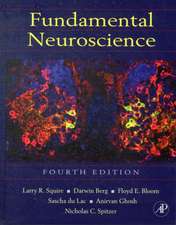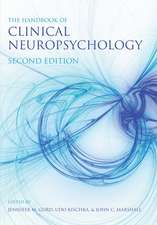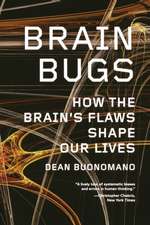Brain Dynamics: Progress and Perspectives: Springer Series in Brain Dynamics, cartea 2
Editat de Erol Başar, Theodore H. Bullocken Limba Engleză Paperback – 19 ian 2012
Preț: 657.73 lei
Preț vechi: 773.80 lei
-15% Nou
Puncte Express: 987
Preț estimativ în valută:
125.87€ • 136.68$ • 105.73£
125.87€ • 136.68$ • 105.73£
Carte tipărită la comandă
Livrare economică 22 aprilie-06 mai
Preluare comenzi: 021 569.72.76
Specificații
ISBN-13: 9783642745591
ISBN-10: 3642745598
Pagini: 572
Ilustrații: XIX, 547 p. 10 illus. in color.
Dimensiuni: 170 x 242 x 30 mm
Greutate: 0.9 kg
Ediția:Softcover reprint of the original 1st ed. 1989
Editura: Springer Berlin, Heidelberg
Colecția Springer
Seria Springer Series in Brain Dynamics
Locul publicării:Berlin, Heidelberg, Germany
ISBN-10: 3642745598
Pagini: 572
Ilustrații: XIX, 547 p. 10 illus. in color.
Dimensiuni: 170 x 242 x 30 mm
Greutate: 0.9 kg
Ediția:Softcover reprint of the original 1st ed. 1989
Editura: Springer Berlin, Heidelberg
Colecția Springer
Seria Springer Series in Brain Dynamics
Locul publicării:Berlin, Heidelberg, Germany
Public țintă
ResearchCuprins
Basic Approaches.- Introductory Remarks.- The Micro-EEG Represents Varied Degrees of Cooperativity Among Wide-Band Generators: Spatial and Temporal Microstructure of Field Potentials.- Electrogenesis of Evoked Potentials.- Cell Membranes, Electromagnetic Fields, and Intercellular Communication.- The EEG is a Quasi-Deterministic Signal Anticipating Sensory-Cognitive Tasks.- Microstates of the Brain in EEG and ERP Mapping Studies.- Spatiotemporal Aspects of Synergetic Processes in the Auditory Cortex as Revealed by the Magnetoencephalogram.- Theoretical Approaches to Brain Function (Linear and Nonlinear).- Introductory Remarks.- Self-Similarity in Hyperchaotic Data.- Estimation of Correlation Dimensions from Single and Multichannel Recordings — A Critical View.- Correlation Dimensions in Various Parts of Cat and Human Brain in Different States.- Magnetoencephalography and Attractor Dimension: Normal Subjects and Epileptic Patients.- Chaotic Attractors in a Model of Neocortex: Dimensionalities of Olfactory Bulb Surface Potentials Are Spatially Uniform and Event Related.- Dimensional Analysis of the Waking EEG.- A Model of the Generation of Electrocortical Rhythms.- Linearity and Nonlinearity in Electrocortical Waves, and Their Elementary Statistical Dynamics.- Can Artificial Intelligence Help in Finding How Brains May Work?.- Discussion Following Remarks by A. de Callataÿ.- Animal Models in Sensory and Cognitive Processes.- Introductory Remarks.- Comparisons of Sensory and Cognitive Brain Potentials in the Human and in an Animal Model.- Evolution of Compound Field Potentials in the Brain.- Discontinuities in Visual Cortex and Possible Functional Implications: Relating Cortical Structure and Function with Multielectrode/Correlation Techniques.- Subcortical EvokedPotential Correlates of Early Information Processing: Mismatch Negativity in Cats.- “No-Go Potential” in the Prefrontal Cortex of Monkeys.- Epileptic Phenomena in the Neocortex: From Activity of Single Neurons to Field Potentials of Neuronal Pools.- Brain Potentials During Sensory and Cognitive Processes.- Introductory Remarks.- Quantitative Electrophysiological Maps of Mental Activity.- Neuroanatomical Contributions to Individual Differences in P300 Morphology.- Sensory and Cognitive 40-Hz Event-Related Potentials: Behavioral Correlates, Brain Function, and Clinical Application.- The CERP: Event-Related Perturbations in Steady-State Responses.- Noninvasive Functional Investigations into Human Cortical Motor Physiology, Motor Learning, and Motor Imagery.- Signs of Model Making by the Human Brain.- The Clinical Use of P300 Cartography in Diseases with Disturbed Cognitive Processing of the Brain.- Influence of Physostigmine on Cognitive Processing of the Brain.- Semantic Distance and the Electrophysiological Priming Effect.- The Search for Face-Specific Evoked Potentials.- Area-Specific Regulation of Slow Cortical Potentials.- How Brains May Work.- Introductory Remarks.- Panel Discussion: How Brains May Work.- Analysis of Strange Attractors in EEGs with Kinesthetic Experience and 4-D Computer Graphics.- Chaos in Brain Function and the Problem of Nonstationarity: A Commentary.- Epilogue.- Signs of Dynamic Processes in Organized Neural Tissue: Extracting Order from Chaotic Data.















